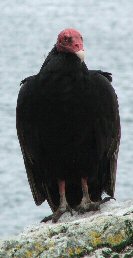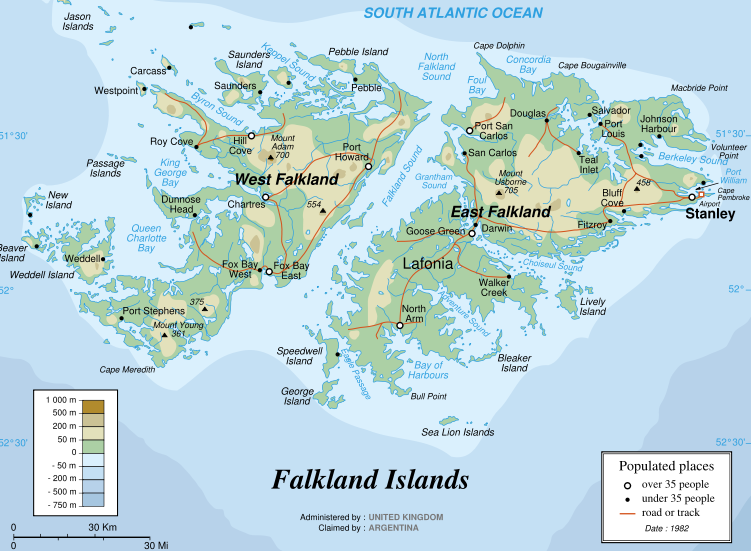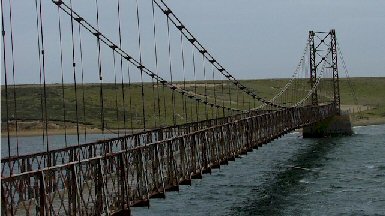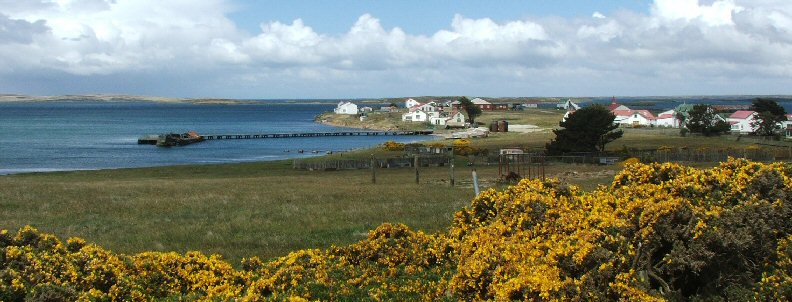Chapter
Eleven - Falkland Frolics - Dec 2008 (Part 1)
 Well,
as said its nearly the end of 2008 & having been away for the last couple
of winters I'm looking forward to Christmas at home with Kate, Blythe &
Zac however I've only just got back to Blighty having spent most of December
basking under blue skies in the Falklands, yes it really was bright & breezy
with not a drop of rain in sight, anyway when I wasn't working I got out &
about & saw a bit more of West Island than I have on previous flying visits
as well as getting in some serious fishing time, see Bangs & Twangs for
tales of Falklands Mullet.
Well,
as said its nearly the end of 2008 & having been away for the last couple
of winters I'm looking forward to Christmas at home with Kate, Blythe &
Zac however I've only just got back to Blighty having spent most of December
basking under blue skies in the Falklands, yes it really was bright & breezy
with not a drop of rain in sight, anyway when I wasn't working I got out &
about & saw a bit more of West Island than I have on previous flying visits
as well as getting in some serious fishing time, see Bangs & Twangs for
tales of Falklands Mullet.
For
most of the time I was there I was fortunate enough to have the use of one of
the company runabouts so I could take more of a leisurely visit to some of the
places I'd visited before such as Gypsy Cove, Surf Bay & Pembrokeshire Lighthouse
where I spent some considerable time watching the antics of the Magellanic penguins
as well as the watching Turkey Vultures of which there seems to be more than
ever.
Things
worked out quite well as the first weekend I was there as the Monday following
was a bank holiday "Battle Day"contrary to what you may think this
has nothing to do with the 1982 conflict but relates to a British naval victory
over the Imperial German Navy on 8 December 1914 during the First World War
in the South Atlantic. The British, embarrassed by a defeat at the Battle of
Coronel on 1 November, sent a large force to track down & destroy the German
cruiser squadron  responsible.
Admiral Graf Maximilian von Spee commanding the German squadron of two armoured
cruisers, SMS Scharnhorst and SMS Gneisenau, & three light cruisers, Nürnberg,
Dresden & Leipzig attempted to raid the British supply base at Stanley on
the Falkland Isles. A larger British squadron of two battlecruisers, HMS Invincible
& HMS Inflexible, pictured picking up survivors as well as three armoured
cruisers, HMS Carnarvon, HMS Cornwall & HMS Kent, & two light cruisers,
HMS Bristol & HMS Glasgow, had arrived in the port only the day before.
Visibility was good: the sea was placid with a gentle breeze from the north
west, the sun bright, the sky clear. The advance cruisers of the German squadron
had been detected early on, & by nine o'clock that morning the British battle-cruisers
and cruisers were in hot pursuit of the five German vessels, these having taken
flight in line abreast to the south-east. By the time it was over all the Imperial
German ships with the exception of the Dresden had been hunted down & sunk
with the loss of 1870 German sailors against a loss of 10 Brit's, in fairness
Battle Day isn't a victory celebration but a day of rememberance for all who
died on that day.
responsible.
Admiral Graf Maximilian von Spee commanding the German squadron of two armoured
cruisers, SMS Scharnhorst and SMS Gneisenau, & three light cruisers, Nürnberg,
Dresden & Leipzig attempted to raid the British supply base at Stanley on
the Falkland Isles. A larger British squadron of two battlecruisers, HMS Invincible
& HMS Inflexible, pictured picking up survivors as well as three armoured
cruisers, HMS Carnarvon, HMS Cornwall & HMS Kent, & two light cruisers,
HMS Bristol & HMS Glasgow, had arrived in the port only the day before.
Visibility was good: the sea was placid with a gentle breeze from the north
west, the sun bright, the sky clear. The advance cruisers of the German squadron
had been detected early on, & by nine o'clock that morning the British battle-cruisers
and cruisers were in hot pursuit of the five German vessels, these having taken
flight in line abreast to the south-east. By the time it was over all the Imperial
German ships with the exception of the Dresden had been hunted down & sunk
with the loss of 1870 German sailors against a loss of 10 Brit's, in fairness
Battle Day isn't a victory celebration but a day of rememberance for all who
died on that day.

Leaving
behind the preparations for the following days "Battle Day" parade
I headed off towards Darwin & then Goose Green, regrettably the population
Goose Green is declining & it's now well under a hundred, consequently its
starting to fall into decline for lack of numbers which is a bit of a pity but
the bright lights of Stanley beckon. I'd hoped to get to see the Bodie Creek
suspension bridge, its supposed to be the most southern suspension bridge in
the world. It was built in 1925, from a UK fabricated kit, in order to shorten
the distance sheep needed to be driven from southern Lafonia to the shearing
sheds in Goose Green, the alternative was a four mile hike. unfortunately I
lucked out, I followed the sign from Goose Green over a pretty rough but dry
track, however I'd only gone a mile or so when the track was well & truely
blocked by barb wire. I had a scout about & couldn't see any sign of the
bridge or a way through so I turned the truck about & disappointedly chugged
back, in hindsight I should have walked from there as I don't think it could
have been much further, next time I won't be put off.


Leaving
Goose Green I continued on to San Carlos which whilst not far as the crow flies,
20 miles or so, takes at least an hour to travel which should give you a fair
idea of the roads your traversing, San Carlos is a small settlement funnily
enough on the on a stretch of water known as the San Carlos Water, no surprises
there then, it gets its name from the ship San Carlos, which first visited in
1768. The settlement grew in the early twentieth century around a factory which
froze sheep carcasses, in recent years though its more known for being the main
British army bridgehead during the conflict in 82 when it was code named "Blue
Beach" There is a small museum, which I passed on, but I did pay my respects
at the British War Cemetery before sharing munchies with two happy but noisey
black pigs.
 After
filling my face I drove back out of San Carlos back the way |I'd headed in as
the road goes no further, a mile or so back along the track however you can
head over the hills via a many gated road & the odd forded river crossing
before reaching Port San Carlos, by the time I got there the weather had turned
decidely iffy, the only time in fact that the sun didn't shine for the whole
of my december visit, when i reached the end of the track it was a bit of a
let down, three or four farms & a couple of defunct tractors, admittedly
the weather crapped out & the grimancing ewes probably coloured my thoughts
as I am told that there's some excellant walking & trout fishing, maybe
nest time.
After
filling my face I drove back out of San Carlos back the way |I'd headed in as
the road goes no further, a mile or so back along the track however you can
head over the hills via a many gated road & the odd forded river crossing
before reaching Port San Carlos, by the time I got there the weather had turned
decidely iffy, the only time in fact that the sun didn't shine for the whole
of my december visit, when i reached the end of the track it was a bit of a
let down, three or four farms & a couple of defunct tractors, admittedly
the weather crapped out & the grimancing ewes probably coloured my thoughts
as I am told that there's some excellant walking & trout fishing, maybe
nest time.
Turning
about I decided that I could risk going off road to Elephant beach or Cape Dolphin
as irrespective of the weather without a second vehicle or knowing exactly where
the bugger I was going it would be pretty bloody stupid, dam, sounds like I'm
getting responsible in my old age, again this'll be a visit for next time, so
heading back North I headed for Teal Inlet. amazingly the weather soon improved
which did tempt me to turn about butlooking at the map I maintained my sensibility
& stuck to the thin grey line.
Teal
Inlet is a settlement of some half dozen homesteads on the south shore of Salvador
Water overshadowed by Jack’s Mountain however it does seem to boast an inordinate
number of retired, battered & dying Landrovers, absolutely fantastic, pictures
elsewhere on the site, like everywhere else in FI it features sheep or in this
case fleeces; I'm told that whilst NZ has more sheep than any other place in
the world, FI has more sheep pro rata to population.

So
with the clock ticking on & the Murrell whispering in my ear I headed up
the road & over the pass between Mt Kent & Mt Tumbledown, passed Estancia
& finally got back on the road to Stanley where I made a quick stop to pick
up the rod & twenty minutes later I was playing a Falkland Mullet of about
2lbs into the shallows which shortly thereafter was devoured by me for tea,
a tasty end to a interesting day.

Back
to Antarctica
 Well,
as said its nearly the end of 2008 & having been away for the last couple
of winters I'm looking forward to Christmas at home with Kate, Blythe &
Zac however I've only just got back to Blighty having spent most of December
basking under blue skies in the Falklands, yes it really was bright & breezy
with not a drop of rain in sight, anyway when I wasn't working I got out &
about & saw a bit more of West Island than I have on previous flying visits
as well as getting in some serious fishing time, see Bangs & Twangs for
tales of Falklands Mullet.
Well,
as said its nearly the end of 2008 & having been away for the last couple
of winters I'm looking forward to Christmas at home with Kate, Blythe &
Zac however I've only just got back to Blighty having spent most of December
basking under blue skies in the Falklands, yes it really was bright & breezy
with not a drop of rain in sight, anyway when I wasn't working I got out &
about & saw a bit more of West Island than I have on previous flying visits
as well as getting in some serious fishing time, see Bangs & Twangs for
tales of Falklands Mullet. responsible.
Admiral Graf Maximilian von Spee commanding the German squadron of two armoured
cruisers, SMS Scharnhorst and SMS Gneisenau, & three light cruisers, Nürnberg,
Dresden & Leipzig attempted to raid the British supply base at Stanley on
the Falkland Isles. A larger British squadron of two battlecruisers, HMS Invincible
& HMS Inflexible, pictured picking up survivors as well as three armoured
cruisers, HMS Carnarvon, HMS Cornwall & HMS Kent, & two light cruisers,
HMS Bristol & HMS Glasgow, had arrived in the port only the day before.
Visibility was good: the sea was placid with a gentle breeze from the north
west, the sun bright, the sky clear. The advance cruisers of the German squadron
had been detected early on, & by nine o'clock that morning the British battle-cruisers
and cruisers were in hot pursuit of the five German vessels, these having taken
flight in line abreast to the south-east. By the time it was over all the Imperial
German ships with the exception of the Dresden had been hunted down & sunk
with the loss of 1870 German sailors against a loss of 10 Brit's, in fairness
Battle Day isn't a victory celebration but a day of rememberance for all who
died on that day.
responsible.
Admiral Graf Maximilian von Spee commanding the German squadron of two armoured
cruisers, SMS Scharnhorst and SMS Gneisenau, & three light cruisers, Nürnberg,
Dresden & Leipzig attempted to raid the British supply base at Stanley on
the Falkland Isles. A larger British squadron of two battlecruisers, HMS Invincible
& HMS Inflexible, pictured picking up survivors as well as three armoured
cruisers, HMS Carnarvon, HMS Cornwall & HMS Kent, & two light cruisers,
HMS Bristol & HMS Glasgow, had arrived in the port only the day before.
Visibility was good: the sea was placid with a gentle breeze from the north
west, the sun bright, the sky clear. The advance cruisers of the German squadron
had been detected early on, & by nine o'clock that morning the British battle-cruisers
and cruisers were in hot pursuit of the five German vessels, these having taken
flight in line abreast to the south-east. By the time it was over all the Imperial
German ships with the exception of the Dresden had been hunted down & sunk
with the loss of 1870 German sailors against a loss of 10 Brit's, in fairness
Battle Day isn't a victory celebration but a day of rememberance for all who
died on that day.


 After
filling my face I drove back out of San Carlos back the way |I'd headed in as
the road goes no further, a mile or so back along the track however you can
head over the hills via a many gated road & the odd forded river crossing
before reaching Port San Carlos, by the time I got there the weather had turned
decidely iffy, the only time in fact that the sun didn't shine for the whole
of my december visit, when i reached the end of the track it was a bit of a
let down, three or four farms & a couple of defunct tractors, admittedly
the weather crapped out & the grimancing ewes probably coloured my thoughts
as I am told that there's some excellant walking & trout fishing, maybe
nest time.
After
filling my face I drove back out of San Carlos back the way |I'd headed in as
the road goes no further, a mile or so back along the track however you can
head over the hills via a many gated road & the odd forded river crossing
before reaching Port San Carlos, by the time I got there the weather had turned
decidely iffy, the only time in fact that the sun didn't shine for the whole
of my december visit, when i reached the end of the track it was a bit of a
let down, three or four farms & a couple of defunct tractors, admittedly
the weather crapped out & the grimancing ewes probably coloured my thoughts
as I am told that there's some excellant walking & trout fishing, maybe
nest time.
